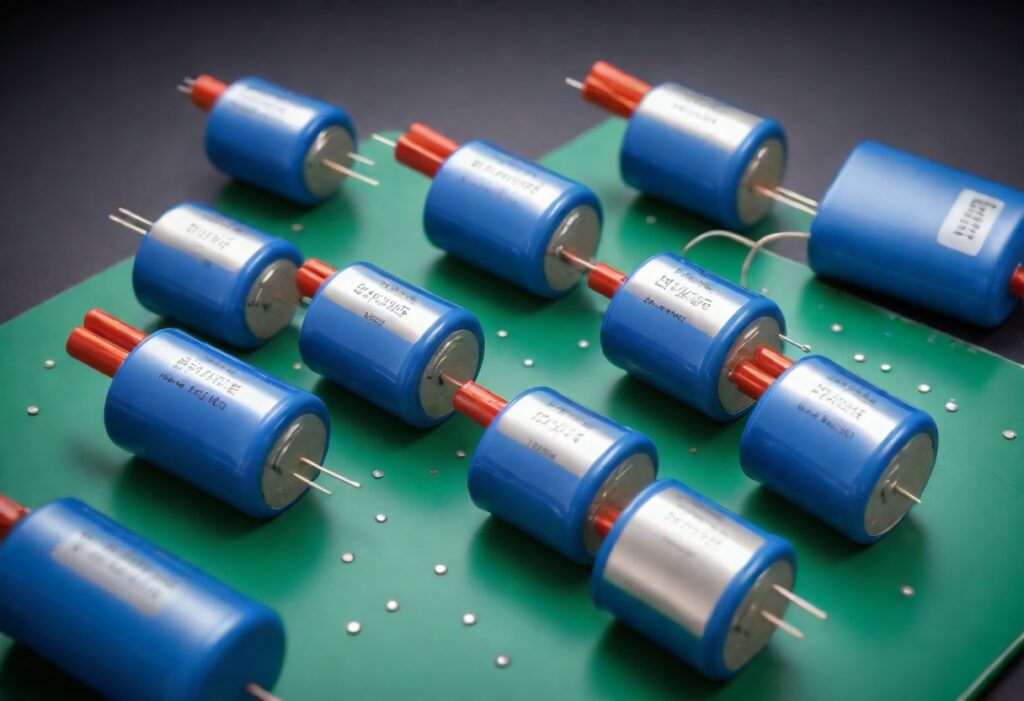Supercapacitors, also called ultracapacitors or electrochemical capacitors, are devices for storing energy. They’ve become quite popular lately because of their special features and many uses. Unlike regular batteries, which store energy through chemical reactions, supercapacitors store energy electrically. This piece explores how supercapacitors work, recent improvements, and the many ways they’re used across different fields.
Understanding Supercapacitors
Supercapacitors, also called ultracapacitors or electrochemical capacitors, are a modern way to store energy. They are different from regular batteries because they store energy using electricity instead of chemicals. This makes them able to charge and discharge very quickly, which is important for many uses in technology today.
Inside a supercapacitor, there are two electrodes, like plates, surrounded by a liquid called an electrolyte. There’s also something called a separator to keep the electrodes from touching. These electrodes are usually made of materials with lots of tiny holes on their surface, like activated carbon or carbon nanotubes. These tiny holes help to store a lot of energy in the supercapacitor.
When we put electricity into a supercapacitor, charges gather on the surfaces of the electrodes. This creates what’s called a double layer of ions. This double layer helps to store energy in the supercapacitor. Because of this, supercapacitors can release and store a lot of energy quickly. This makes them great for things like electric cars or systems that use renewable energy.
Some supercapacitors also use another way to store energy called pseudocapacitance. This happens when certain materials in the supercapacitor go through chemical changes as they charge and discharge. This helps to store even more energy in the supercapacitor.
The way a supercapacitor works depends on many things, like the materials it’s made of and how it’s built. Scientists are always trying to find better materials and ways to make supercapacitors store more energy, charge faster, and last longer.
Overall, supercapacitors are great because they can store a lot of energy, charge and discharge quickly, and last a long time. They can be used in many different ways, like in phones, renewable energy systems, and cars. They are important for the future of technology and energy storage.
Improvements in Supercapacitor Technology
Improvements in supercapacitor technology have sped up lately. This is because people want energy storage solutions that can store a lot of power, charge and discharge quickly, and last a long time. These improvements are thanks to new discoveries in materials science, the chemistry of liquids used, and how the devices are made. They’re leading to better supercapacitors that work more reliably and efficiently.
One big area of progress is in the materials used for the parts inside supercapacitors. Normally, they use a material called activated carbon. But scientists are now looking at other materials like graphene. Graphene is a very thin and strong kind of carbon. It can store more energy and charge and discharge faster than activated carbon.
Another area of improvement is in the liquids used inside supercapacitors. These liquids help move charges around. Scientists are testing different kinds of liquids to make supercapacitors store more energy and last longer.
People are also finding new ways to make supercapacitors. One idea is to combine them with batteries to make hybrid devices. These devices would store a lot of energy like batteries but charge and discharge quickly like supercapacitors. There are also new ways to make supercapacitors using machines like 3D printers. This makes it easier to make them in different shapes and sizes.
These advancements in supercapacitor technology are creating new possibilities for storing and using energy in many different areas. By using new materials, liquids, and ways to make them, researchers are making supercapacitors better. They’re helping us move towards a future where we use energy more sustainably and efficiently.
Applications of Supercapacitors
Supercapacitors are special because they can store a lot of power, charge and discharge quickly, and last a long time. They’re being used in many industries, like consumer electronics, renewable energy, and transportation, to change how we use and save energy.
In consumer electronics, supercapacitors are becoming more common. They can provide backup power when there’s a short outage and make battery-powered devices work better. For instance, in smartphones and laptops, supercapacitors can give a quick boost of power when needed, which helps the battery last longer. They’re also useful in wearable devices and gadgets connected to the internet, making them charge and work faster.
In renewable energy systems, like solar and wind power, supercapacitors help store extra energy. They do this by collecting extra power when it’s available and releasing it when it’s needed. This helps keep the power supply steady and makes the system more efficient. Supercapacitors are also used in smaller energy systems to provide backup power if the main power source fails.
In transportation, supercapacitors are important in hybrid and electric vehicles (EVs). When these vehicles slow down, supercapacitors can store the energy they produce. This energy can then be used later to help the vehicle speed up or to support the main battery. This saves energy, makes the battery last longer, and improves how the vehicle works.
Supercapacitors are also being tested for use in industries like energy storage for large power grids, managing power quality, and backup power. In manufacturing and automation, they’re used to make sure machines keep running smoothly even if there’s a power problem.
In short, supercapacitors are very useful in many different areas. As we learn more about them and improve how they work, they’ll become even more important in saving and using energy better.
The Future and Challenges
Supercapacitors are promising for the future of storing energy because they can store a lot of power and charge and discharge quickly. But there are challenges that need to be solved to make them even better and used more widely.
One important challenge is finding better materials for making supercapacitors. Traditionally, they use a material called activated carbon. But researchers are looking into other materials like graphene, carbon nanotubes, and metal oxides. These materials have special properties that can make supercapacitors store more energy and charge faster.
Another challenge is making supercapacitors easier and cheaper to make. Right now, making supercapacitors involves complicated and expensive processes. Researchers are trying new ways to make them, like using printers or sprays, to make them faster and cheaper.
Using supercapacitors together with other energy storage systems is also a challenge. Supercapacitors have some advantages over regular batteries, like charging faster and lasting longer. But they also have limits, like not storing as much energy. Researchers are trying to combine supercapacitors with batteries and other technologies to make systems that work better.
Finally, making systems to control and manage supercapacitors is important. These systems need to be able to watch how much energy is stored, manage when the supercapacitor is charged or discharged, and protect it from getting too much electricity. Also, better electronics and power management technologies are needed to fit supercapacitors into existing systems and devices.
In conclusion, there’s been a lot of progress in making supercapacitors better, but there are still challenges to solve. By working on these challenges, supercapacitors can be used in many areas like phones, renewable energy, and cars. They have the potential to change how we save and use energy, making it better for the future.










More Stories
Securing the Cyberspace: DDoS Attacks and Botnets
Securing the Connected: Cybersecurity Strategies for IoT
The Power of Cloud Storage: Advantages for Modern Businesses